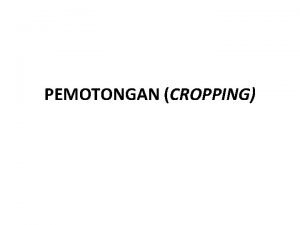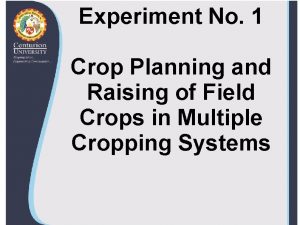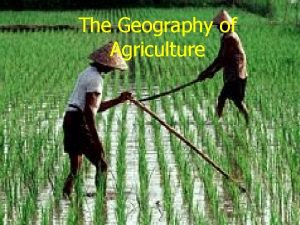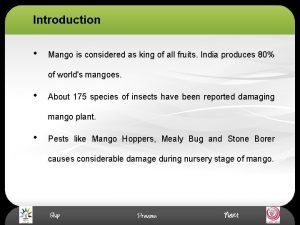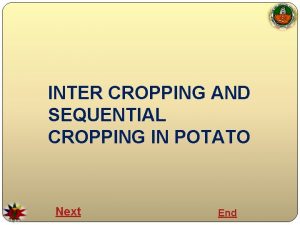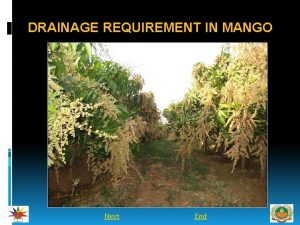INTER CROPPING IN MANGO Next End INTRODUCTION As














- Slides: 14

INTER CROPPING IN MANGO Next End

INTRODUCTION Ø As mango 'trees take longer time to yield any profit to the grower. it is desirable to supplement one's income by growing some short-term crops till they are shaded by the trees. Ø Such crops when taken in the orchard are called intercrops. Previous Next End

PRINCIPLES OF INTERCROPPING • Intercrops should occupy a secondary place in the orchard, primary consideration being given to the perennial fruit trees. • The crops that may grow tall and have a tendency towards excessive growth should be discouraged. • Water requirements of the At least 120 cm radius must be left from intercrops should as far as the base of the growing fruit trees for possible coincides with the taking intercrops. requirement of fruit trees. Previous Next End

• Such intercrops should be selected that do not exhaust the nutrients and moisture from the soil, so essential for the growth of fruit trees. • Perennial or exhaustive crops should be discouraged as an intercrop in the orchard. • This may have devitalizing effect on the growing trees. For example, sugarcane, pigeonpea, maize, jowar should invariably be excluded from an intercropping programme in the orchard. Previous Next End

DIFFERENT INTERCROPS • Vegetables that have their roots within 25 cm depth of the soil are considered good for intercropping. • These are tomato, onion, cauliflower, beans, radish, palak etc. • These vegetables can be taken profitably in a growing orchard by appropriate application of nutrients to the soil and also maintaining an optimum level of moisture. • Among the annual crops, due consideration should be given to the legumes such as pea, lentil, moth bean, black gram and green gram. Previous Next End

FRUIT CROPS AS INTERCROPS • Short-term and early bearing fruit crops as an intercrop, due consideration is essential in the selection of a particular fruit. • This is essential because the roots of such trees may start competing with the roots of main fruit trees for nutrients and moisture. • The filler trees, unless removed at appropriate time when primary fruit trees start giving economic crop, may create problems of low orchard efficiency. • Keeping this point in mind, it is apparent that wherever pineapple and strawberry can be grown, these may serve as an ideal intercrop. Previous Next End

• Wherever frost hazard is less, an intercrop of papaya can be taken profitably in a mango orchard. • Likewise, in the northern plains of India, 'Sharbati' peach can be an excellent intercrop for mango orchard. • Phalsa and guava could also be included in the early stages of growth of the trees, provided these are maintained properly by adequate pruning and removal at proper time. Previous Next End

OTHER CROPS • During the first few years of their non- bearing life and until the trees have grown to a big size, the vacant land in between the mango trees can be profitably utilized for the cultivation of harmless types of intercrops like fodders, farm crops, vegetables and pulses preferably of leguminous type. • Intercropping should always be judicious and needs of the trees receive primary consideration, otherwise the practice may prove extremely harmful. • Intercropping helps to keep the weeds under check, which otherwise would rob the orchard soil of plant nutrients and moisture. Previous Next End

• While intercropping, the trees should be provide with suitably wide basins and an independent irrigation system. • They should also be given regular hoeings and weedings. When the trees grow up to big size, as it usually happens after their 10 -12 years of life. • Then discontinue the intercropping as at that stage it would impair with their normal growth and fruiting. • In order to replenish the organic matter content of the soil, green manuring with leguminous crops like guara, hemp and senji may be carried out, depending upon the need of the soil. Previous Next End

• Instead of intercropping, temporary quick growing fruit trees can be grown as fillers which are removed when the mango trees assume big size. • Papaya, peach, plum, guava and phalsa are grown as fillers. • Mango orchard provides an opportunity for utilizing the land space to its maximum during initial years (up to 8 -10 years) of establishment. • Due to wider spacing and developing root patterns, the large unutilized inter-space of about 60 to 70 % can be exploited for growing inter and mixed crops successfully. S • election of intercrops depends on agro climatic region, marketing facilities, levels of inputs and other local considerations. Previous Next End

• Leguminous crops like green gram, black gram, oilseeds like sesame and groundnut and vegetables crops such as cabbage, cauliflower, tomato, potato, brinjal, cucumber, pumpkin, bitter gourd, bhendi, etc. and spices like chillies can be successfully grown as intercrops. • The partial shade loving crops like pineapple, ginger, turmeric, etc. can be grown in fully grown orchards. • In addition to field crops, some short duration, less exhaustive and dwarf type inter-fillers like papaya, moringa, curry leaf, etc. can also be grown till these do not interfere with the main mango crop. Previous Next End

• Intercropping can be taken up till the mango trees attain suitable height and develop canopy (at 5 -6 years of age). • In addition to field crops, some short duration , less exhaustive and dwarf type inter- fillers like papaya, guava, peach, plum etc. can be grown till these do not interfere with the main mango crop. • It is advisable to take vegetable crops as inter crops for better returns. • Certain vegetables can be intercropped viz. , onion, tomato, radish, carrot, cabbage, peas, colocasia, ginger, turmeric, methi, palak, amarnathus etc. besides fruit crops can also be grown viz. , papaya, phalsa, straw berry, pineapple etc. for initial 4 -5 years. Previous Next End

• Any short duration crop relevant to the specific location can be selected. • Some intercrops suitable include vegetables such as onion, tomato, radish, carrot, cowpea, cluster bean, French bean, okra, amaranthus, colocasia, spice like ginger, turmeric, methi, pulse like horse gram, black gram and fruit crops such as papaya, pineapple, phalsa and straw berry. • Whatever be the crops selected intercrop and main crop must receive separately their independent requirement of fertilizer and irrigation. Previous Next End

• Inter cropping result in increased humidity and vegetation in orchard that may promote infestation of pest and diseases in greater intensity than under clean cultivation. • In general, an intercrop must be planted well away from the mango plants and their requirements for moisture and nutrients must be met separately and must not clash with those for mango. • With the increasing age of mango plants, the area under intercrops should be progressively decreased to avoid competition. • One must vigilant to adopt timely and effective control measures against pests and diseases affecting the intercrop. Previous Next End
 X.next = x.next.next
X.next = x.next.next Strip cropping
Strip cropping Cropping citra adalah
Cropping citra adalah Multiple cropping index formula
Multiple cropping index formula What is mixed cropping
What is mixed cropping Double cropping ap human geography
Double cropping ap human geography Buffer strip cropping
Buffer strip cropping Photoshop freezes when cropping
Photoshop freezes when cropping House on mango street introduction
House on mango street introduction Mango introduction
Mango introduction Heart stroke volume
Heart stroke volume End-diastolic volume vs end-systolic volume
End-diastolic volume vs end-systolic volume Front end of compiler
Front end of compiler Back end phases of compiler
Back end phases of compiler Kolondivertikulose
Kolondivertikulose


